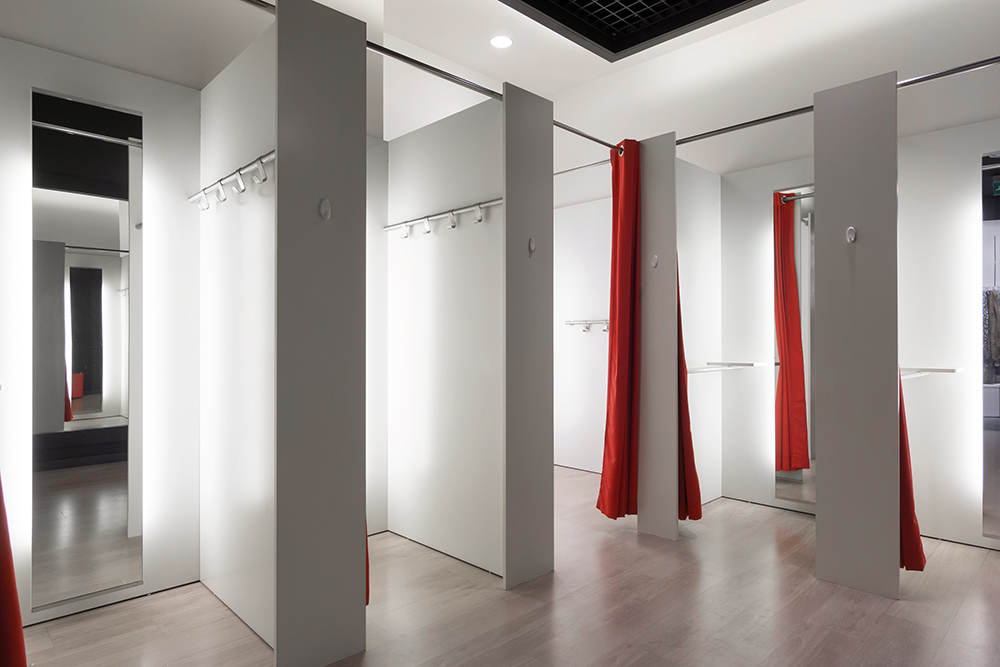Rethinking the fitting room

In recent years the fitting room hasn’t had much thought. A couple of curtains, a little privacy, an attendant to count items in and out – voila change rooms taken care of.
But in an age where the customer experience matters more than ever before, the fitting room is offering apparel retailers a welcome opportunity to stand out from the crowd.
More importantly, the fitting room plays to a unique strength of bricks and mortar, where consumers can feel, see and physically experience how an item looks when they wear it.
Here are five ways to rethink the fitting room experience…
The non-negotiables
Fitting rooms are about the experience of trying something on, which means they should be clean, private and offer sufficient space to actually get changed and put some items down as the customer does so. A bench is recommended while at least two hooks are the minimum requirement.
Mirrors are of course a non-negotiable, but multiple mirrors are better than a single mirror as they offer the chance to view items from different angles.
Importantly, lighting plays a critical role. Too often fitting room lighting is harsh and fluorescent or too dim to see the items properly.
Fitting room lighting should resemble natural lighting where possible, so customers can understand exactly how an item would look in the real-world.
Meanwhile, natural lighting tends to showcase products better, making them more appealing to the consumer while allowing them to feel good about themselves.
A welcoming space
In addition to being a functional space that offers good lighting, adequate mirrors and usable design, the fitting room is also the opportunity to welcome customers in and extend awareness of your brand.
As such, the area should be designed accordingly, with a colour scheme that suits and a focus on experience rather than pure functionality.
That means rethinking its purpose and committing to it. For example, the fitting room is not an overflow area for stock, it is a space that should be visually welcoming and inviting, allowing consumers to enjoy the social, tactile and physical experience of apparel shopping.
Get smart

Smart technology is starting to play a real role in the fitting room and can be harnessed to great effect.
Whether it’s a touchscreen that allows a customer to see other similar items or styles that are available, or a smart mirror that allows them to see how a product would look in a different colour, this technology enables the customer to become engaged in the testing and trying experience.
Critically, smart technology can also save on staff resources, allowing them to be summoned when an item is required. It can also facilitate upselling, as the technology can suggest accompanying items.
Cater to tech
On the note of tech, many fitting room designers are now suggesting change rooms should cater to it. For example, it’s become common practice for people to take a selfie of themselves wearing a product and then seek the opinion of their friends, so retailers should be building this into the fitting room experience.
Personalised fashion expert MYHOLM recommends fitting rooms should have selfie-friendly lighting and a colour scheme that pops so people are more likely to take images of themselves in your brand and share them.
Service, service, service
The fitting room might be experiencing a rise in tech, but it’s still a prime opportunity for service and staff should be at the centre of providing one that’s second to none.
The change room is the chance for sales associates to offer their expertise rather than just counting items in and out. That skill might be in product recommendations, alternative colours or accompanying items.
But personalised one-on-one service is a bricks and mortar strength that should be played to its absolute advantage.
Consider loss prevention
As much as the fitting room is about service and experience, it’s also about loss prevention. A prime site for shoplifting due to its private nature, protecting the fitting room is essential. And this comes down to a combination of good design, technology and that service we mentioned earlier.
While benches and mirrors are a must, they should be designed to have no hidden cavities were items or security tags can be secreted.
Meanwhile, technology like the Fitting Room Guard alerts staff to tag tampering or the use of booster bags which can be used to conceal items.
A friendly staff member who frequently engages with consumers in the fitting room also helps prevent theft, and they should be trained to keep a subtle yet watchful eye on exactly what’s going in and out of the area.
The final word
No longer just an area, the fitting room offers real opportunity to apparel retailers looking to offer a point of difference. Designed well with the customer front of mind, they can transform the routine of trying something on into a complete and immersive brand and service experience.